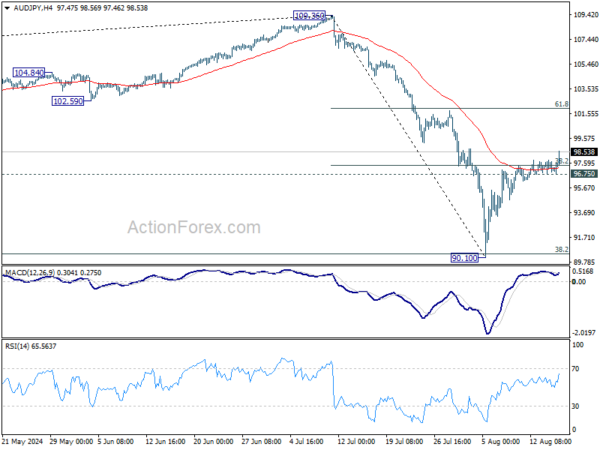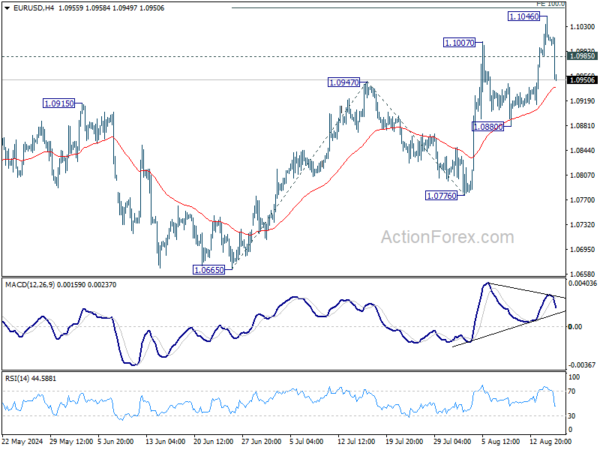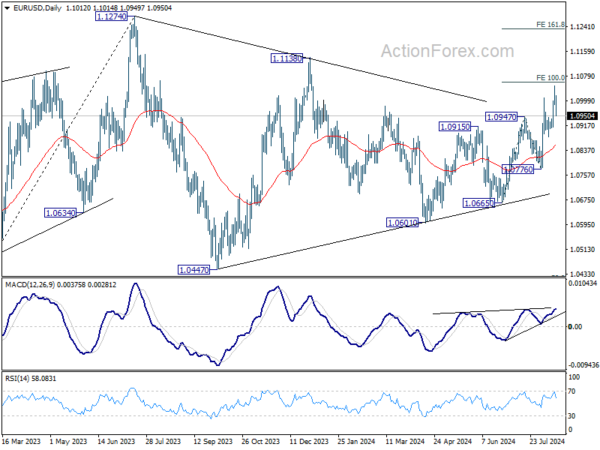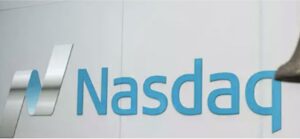The US markets reacted positively today to stronger-than-expected retail sales data, which posted its fastest growth in a year and a half. Additionally, better-than-expected jobless claims numbers helped alleviate concerns about weaknesses in the employment market. The robust rally in US futures, along with rising yields and a stronger Dollar, suggests that traders have temporarily set aside recession fears.
Following yesterday’s CPI data, which met expectations, Fed remains on course to cut interest rates in September. However, the likelihood of a large rate cut has diminished. Fed fund futures are now pricing in only a 25% chance of a 50 basis point cut, down from over 50% just a few days ago.
In the currency markets, Australian Dollar stands out as the strongest performer of the day, buoyed by much stronger-than-expected employment data. However, despite the initial surge, there is no clear follow-through momentum yet. Dollar is the second strongest, supported by positive economic data in the early US session.
Conversely, the Japanese Yen is among the weakest, as its near-term pullback seems to be evolving into a broader reversal amid rising US and European benchmark yields. Swiss Franc also weakened, pressured by a shift to risk-on sentiment. Euro, British Pound, and Canadian Dollar are trading in a more neutral position.
Technically, AUD/JPY is currently the biggest mover today, up more than 1%. The strong break of 38.2% retracement of 109.36 to 90.10 at 97.45 suggests that fall from 109.36 has completed at 90.10 already. Rebound from there is seen as the second leg of the medium term corrective pattern from 109.36. Further rise is now in favor as long as 96.75 minor support holds, to 61.8% retracement at 102.00 and possibly above.

In Europe, at the time of writing, FTSE is up 0.53%. DAX is up 1.11%. CAC is up 0.87%. UK 10-year yield is up 0.0845 at 3.913. Germany 10-year yield is up 0.055 at 2.240. Earlier in Asia, Nikkei rose 0.78%. Hong Kong HSI fell -0.02%. China Shanghai SSE rose 0.94%. Singapore Strait Times rose 0.90%. Japan 10-year JGB yield rose 0.0247 to 0.838.
US retail sales rose 1% mom in Jul, ex-auto sales up 0.4% mom
US retail sales rose 1.0% mom to USD 709.7B in July, above expectation of 0.3% mom. Ex-auto sales rose 0.4% mom to USD 576.1B, above expectation of 0.1% mom. Ex-gasoline sales rose 1.0% mom to USD 657.1B. Ex-auto& gasoline sales rose 0.4% mom to USD 523.4B.
Total sales for the May through July period rose 2.4% from the same period a year ago.
US initial jobless claims fall to 227k, vs exp 239k
US initial jobless claims fell -7k to 227k in the week ending August 10, lower than expectation of 239k. Four-week moving average of initial claims fell -4.5k to 236.5k.
Continuing claims fell -7k to 1864k in the week ending August 3. Four-week moving average of continuing claims rose 1k to 1862k, highest since November 27, 2021.
UK GDP flat in June, up 0.6% qoq in Q2
UK GDP showed no growth in June, matched expectations. Services output fell by -0.1% mom after five consecutive monthly increases. Production grew by 0.8% mom. Construction grew by 0.5% mom.
For Q2, GDP grew 0.6% qoq, matched expectations. Services grew by 0.8% qoq. Production fell -0.1% qoq. Construction also fell -0.1% qoq.
Japan’s Q2 GDP grows 0.8% qoq on strong consumption and capital spending
Japan’s economy showed stronger-than-expected growth in Q2, with real GDP rising by 0.8% qoq, surpassing the anticipated 0.6% qoq increase. On an annualized basis, GDP surged by 3.1%, well above the expected 2.1%. This marks a significant rebound after the sharp contraction experienced in Q1, and it is the first increase in two quarters.
The recovery was largely driven by a notable rise in private consumption, which increased by 1.0%. This is particularly significant as it follows four consecutive quarters of decline, a losing streak not seen since the aftermath of the 2008 financial crisis. Additionally, capital spending grew by 0.9%, marking its first gain in two quarters.
On a nominal basis, GDP increased by 1.8% in Q2, translating to an annualized rate of 7.4%. This growth pushed Japan’s GDP above JPY 600T for the first time, a milestone attributed to the ongoing inflationary pressures driven by the weakening Yen.
Australia’s employment surges 58.2k while unemployment rate ticks up
Australia’s labor market showed robust growth in July, with employment rising by 58.2k, significantly surpassing expectations of 26.5k. This increase was driven by a strong gain in full-time employment, which rose by 60.5k, while part-time employment saw a slight decline of -2.3k.
Unemployment rate ticked up from 4.1% to 4.2%, slightly higher than the expected 4.1% and marking the highest level since November 2021. This increase in the unemployment rate comes alongside a rise in the participation rate, which climbed from 66.9% to a record high of 67.1%. Additionally, the employment-to-population ratio edged up by 0.1% to 64.3%, just shy of the historical high of 64.4% set in November of last year. Monthly hours worked also increased by 0.4% mom.
Kate Lamb, ABS head of labour statistics, noted that while the unemployment rate has increased by 0.1 percentage point in each of the past two months, the record high participation rate and near-record employment-to-population ratio indicate that “there continues to be a high number of people in jobs, and looking for and finding jobs.”
RBNZ’s Orr signals careful and measured rate reductions
RBNZ Governor Adrian Orr outlined the central bank’s approach to its recent monetary policy shift in an interview with Bloomberg TV today. Following the unexpected rate cut that initiated the easing cycle yesterday, Orr emphasized that RBNZ intends to lower interest rates toward a more neutral setting at a “careful and measured pace.” This strategy is aimed at ensuring that inflation expectations remain firmly anchored at the 2% target, which Orr stated is the central bank’s “single focus.”
Orr expressed confidence in the central bank’s course of action, noting that key indicators of inflation pressures are moving in the right direction. RBNZ has been closely monitoring “price-setting behavior,” “inflation expectations,” and “domestic homegrown inflation components.” According to Orr, all these factors are now aligned with the goal of restoring “low and stable inflation” over the next couple of years.
Furthermore, Orr highlighted that various economic indicators are pointing toward a positive outlook for growth. “We see positive economic growth coming and we can be easing interest rates,” he said, expressing optimism that New Zealand could achieve “growth without the inflation.”
China’s industrial production slows while retail sales beat expectations
China’s economic data for July revealed a mixed picture, with industrial production growth continuing to decelerate while retail sales showed unexpected strength. Industrial production rose by 5.1% yoy, down from 5.3% in June and missing the expected 5.2%. This also marks the third consecutive month of slowing growth.
On a more positive note, retail sales increased by 2.7% yoy, accelerating from the previous month’s 2.0% and exceeding expectations of 2.6%.
However, fixed asset investment growth also disappointed, rising by 3.6% year-to-date compared to the same period last year, below the anticipated 3.9%.
EUR/USD Mid-Day Outlook
Daily Pivots: (S1) 1.0981; (P) 1.1014; (R1) 1.1046; More…..
Intraday bias in EUR/USD is turned neutral with current steep retreat. Some consolidations would be seen first. But another rally is in favor as long as 1.0880 support holds. Firm break of 100% projection of 1.0665 to 1.0947 from 1.0776 at 1.1058 could prompt upside acceleration through 1.1138 resistance to 161.8% projection at 1.1232. However, considering bearish divergence condition in 4H MACD, break of 1.0880 will suggest near term reversal and turn bias to the downside for 1.0776 support and below.

In the bigger picture, price actions from 1.1274 are viewed as a corrective pattern that’s could still extend. Break of 1.1138 resistance will be the first signal that rise from 0.9534 (2022 low) is ready to resume through 1.1274 (2023 high). However, break of 1.0776 support will extend the correction with another falling leg back towards 1.0447 support.

Economic Indicators Update
| GMT | Ccy | Events | Actual | Forecast | Previous | Revised |
|---|---|---|---|---|---|---|
| 23:50 | JPY | GDP Q/Q Q2 P | 0.80% | 0.60% | -0.50% | |
| 23:50 | JPY | GDP Deflator Y/Y Q2 P | 3.00% | 2.60% | 3.40% | |
| 01:00 | AUD | Consumer Inflation Expectations Aug | 4.50% | 4.30% | ||
| 01:30 | AUD | Employment Change Jul | 58.2K | 26.5K | 50.2K | 52.3K |
| 01:30 | AUD | Unemployment Rate Jul | 4.20% | 4.10% | 4.10% | |
| 02:00 | CNY | Industrial Production Y/Y Jul | 5.10% | 5.20% | 5.30% | |
| 02:00 | CNY | Retail Sales Y/Y Jul | 2.70% | 2.60% | 2.00% | |
| 02:00 | CNY | Fixed Asset Investment YTD Y/Y Jul | 3.60% | 3.90% | 3.90% | |
| 04:30 | JPY | Industrial Production M/M Jun F | -4.20% | -3.60% | -3.60% | |
| 06:00 | GBP | GDP M/M Jun | 0.00% | 0.00% | 0.40% | |
| 06:00 | GBP | GDP Q/Q Q2 P | 0.60% | 0.60% | 0.70% | |
| 06:00 | GBP | Industrial Production M/M Jun | 0.80% | 0.10% | 0.20% | 0.30% |
| 06:00 | GBP | Industrial Production Y/Y Jun | -1.40% | -2.10% | 0.40% | |
| 06:00 | GBP | Manufacturing Production M/M Jun | 1.10% | 0.10% | 0.40% | 0.30% |
| 06:00 | GBP | Manufacturing Production Y/Y Jun | -1.50% | -2.40% | 0.60% | 0.40% |
| 06:00 | GBP | Goods Trade Balance (GBP) Jun | -18.9B | -16.0B | -17.9B | -18.6B |
| 06:30 | CHF | Producer and Import Prices M/M Jul | 0.00% | 0.20% | 0.00% | |
| 06:30 | CHF | Producer and Import Prices Y/Y Jul | -1.70% | -1.70% | -1.90% | |
| 12:30 | CAD | Wholesale Sales M/M Jun | -0.60% | -0.60% | -0.80% | -1.20% |
| 12:30 | USD | Initial Jobless Claims (Aug 9) | 227K | 239K | 233K | 234K |
| 12:30 | USD | Retail Sales M/M Jul | 1.00% | 0.30% | 0.00% | |
| 12:30 | USD | Retail Sales ex Autos M/M Jul | 0.40% | 0.10% | 0.40% | |
| 12:30 | USD | Import Price Index M/M Jul | 0.10% | 0.00% | 0.00% | |
| 12:30 | USD | Empire State Manufacturing Index Aug | -4.7 | -5.9 | -6.6 | |
| 12:30 | USD | Philadelphia Fed Survey Aug | -7 | 6.6 | 13.9 | |
| 13:15 | USD | Industrial Production M/M Jul | 0.10% | 0.60% | ||
| 13:15 | USD | Capacity Utilization Jul | 78.60% | 78.80% | ||
| 14:00 | USD | Business Inventories Jun | 0.30% | 0.50% | ||
| 14:00 | USD | NAHB Housing Market Index Aug | 43 | 42 | ||
| 14:30 | USD | Natural Gas Storage | 43B | 21B |









